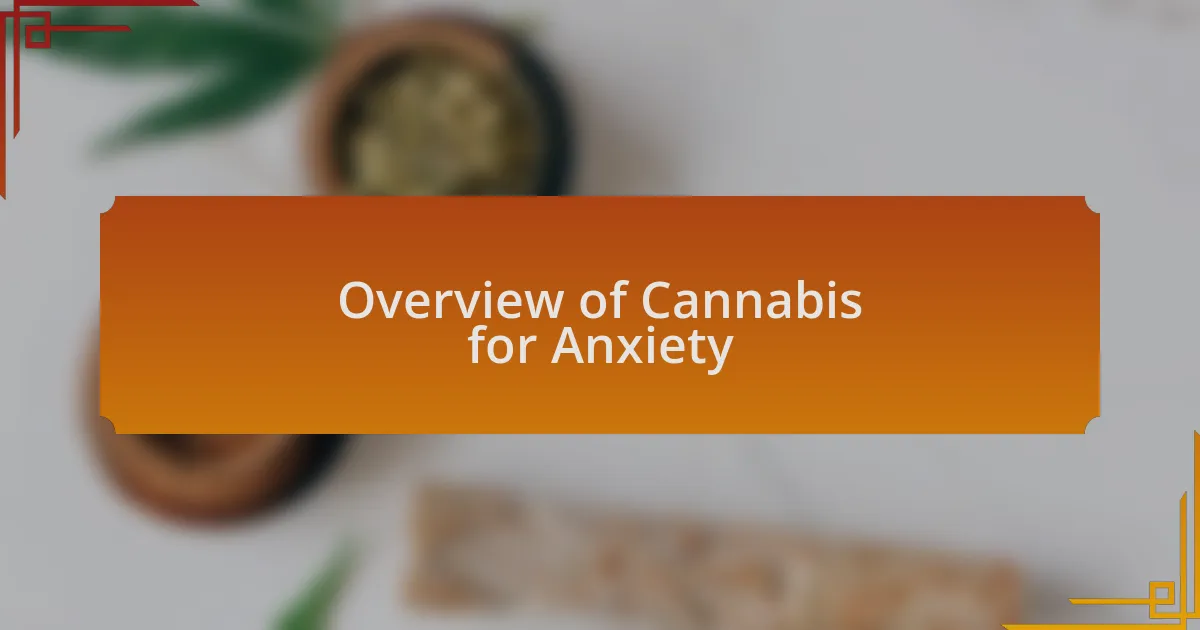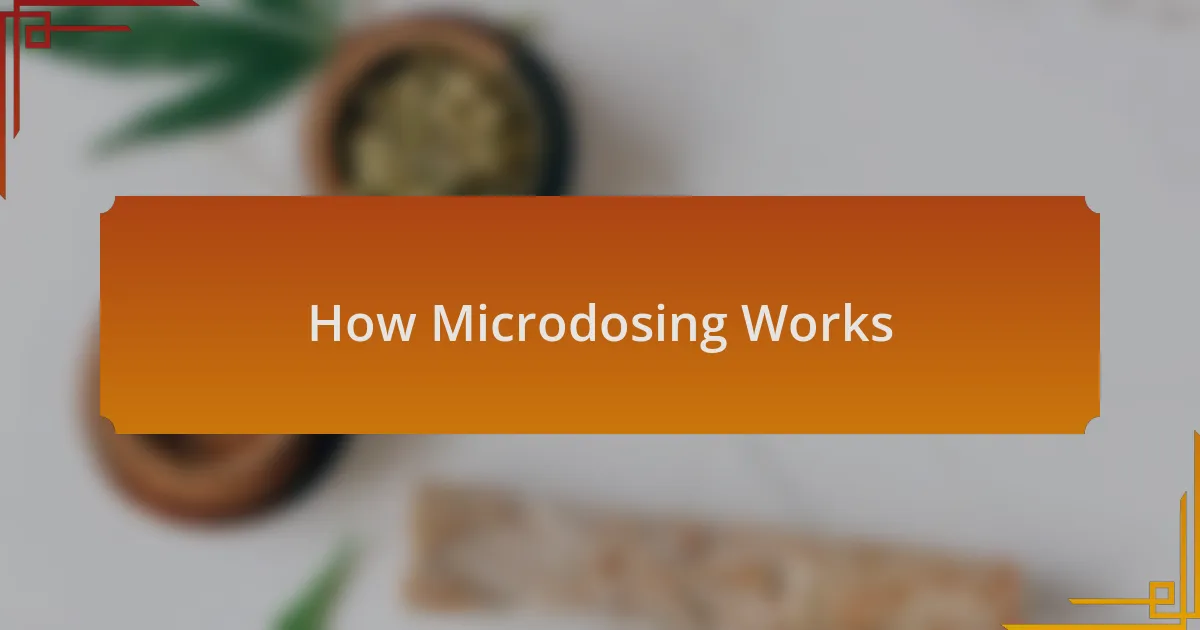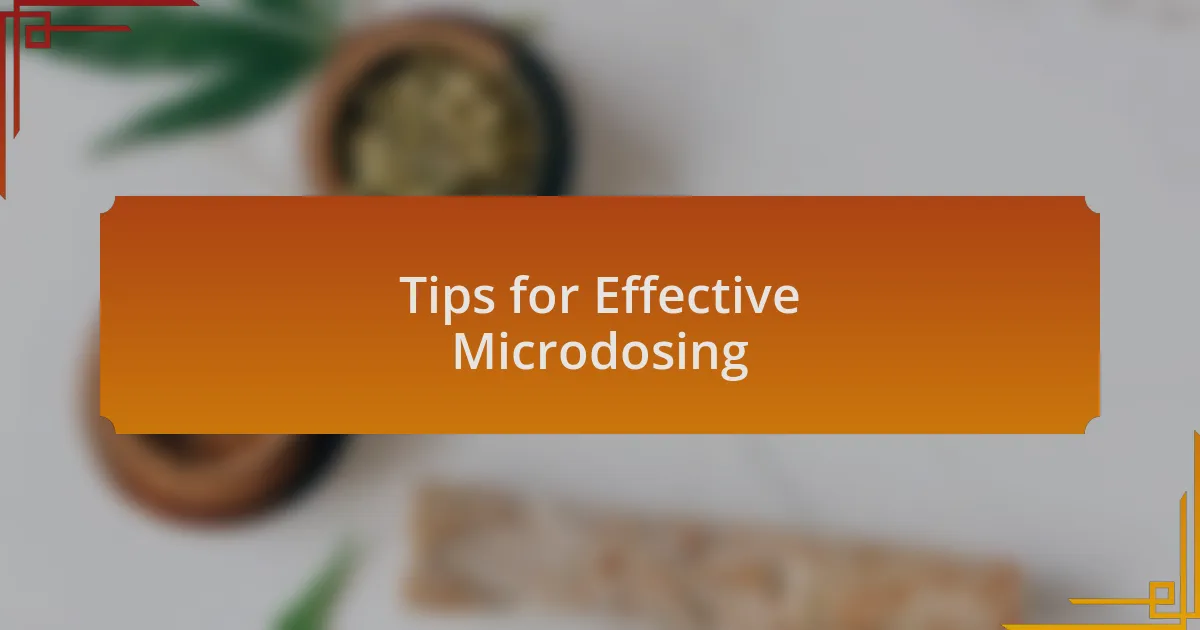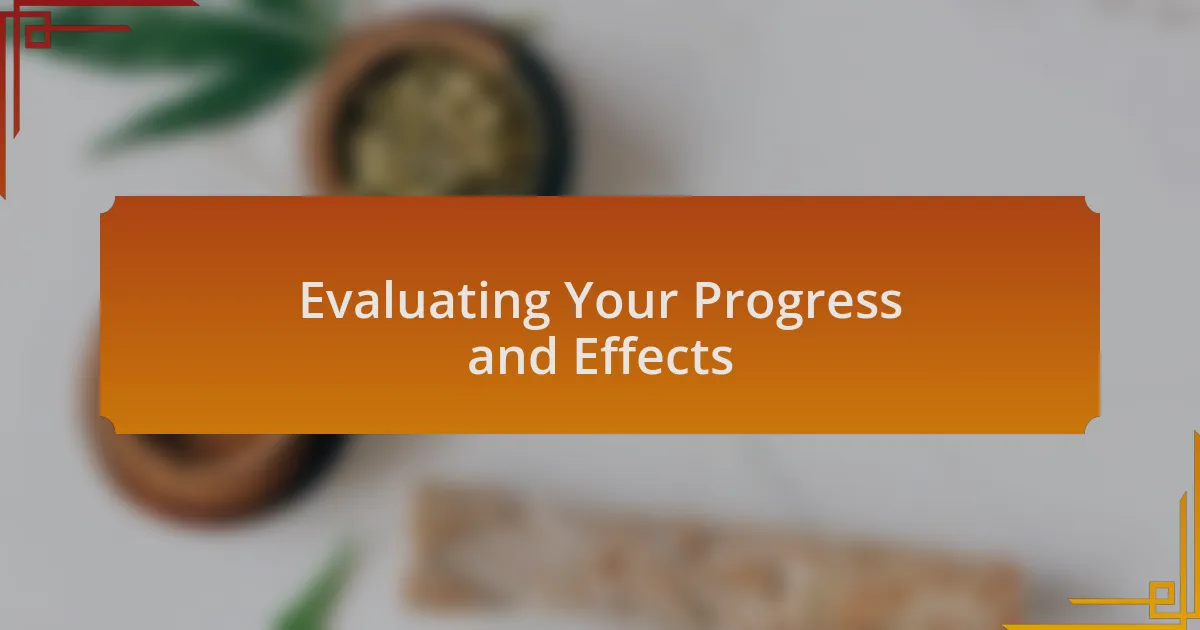Key takeaways:
- Microdosing small amounts of psychedelic substances can enhance creativity, focus, and emotional regulation, offering a clearer mental state and better coping mechanisms for anxiety.
- Cannabis and its components, particularly CBD, can effectively manage anxiety, emphasizing the importance of strain selection for personalized effects.
- Begin with low doses (0.1 to 0.3 grams) and adjust based on personal experience, noting mood changes and effects to find the optimal dosage.
- Regularly evaluate microdosing progress by reflecting on mood changes and discussing experiences with others, fostering a supportive learning environment.

Understanding Microdosing Benefits
When I first delved into microdosing, I found it intriguing how such small amounts of a substance can yield significant changes in one’s mental state. I remember my first experience; I felt a gentle wave of calm that enveloped me, alleviating my nagging anxiety without the fog often associated with higher doses. How many times have we wished for a solution that didn’t leave us in a haze?
Microdosing can often enhance creativity and focus, which was a game-changer for me during particularly stressful workdays. Instead of reaching for my usual coping mechanisms, I experimented with microdosing, and the clarity that followed was remarkable. Have you ever felt that burst of inspiration while simply going about your day? Microdosing can unlock that potential more consistently.
Moreover, the subtle effects of microdosing can lead to improved emotional regulation, making stressful situations more manageable. I recall one tense meeting where rather than feeling overwhelmed, a sense of calm guided my responses. It’s fascinating to think about how such small changes can transform not just our daily tasks, but also the way we handle challenges in life. How empowering would it feel to navigate life’s curveballs with more ease?

Overview of Cannabis for Anxiety
Cannabis has emerged as a popular option for managing anxiety, largely due to its ability to influence the endocannabinoid system. This system plays a critical role in regulating moods and stress responses, and I’ve often found that a low dose of cannabis can ease that tightness in my chest during anxious moments. Has anyone else experienced a shift in perspective after a puff or two?
In my journey with cannabis, I discovered the importance of strain selection. Indica strains, known for their calming properties, often helped me unwind after a long day, while sativa strains could sometimes heighten my anxiety if not dosed carefully. Reflecting on it, it became clear that knowing which type works best for my body was crucial. What if the solution to anxiety lay in the right strain choice?
Another aspect that resonates with me is the impact of CBD, a non-psychoactive component of cannabis that has shown promise for anxiety relief. There were days when I opted for CBD oil instead of my regular coping mechanisms, and the calming effect was impressively soothing. It makes me wonder—could incorporating CBD into a daily routine help others find their own peace without feeling altered?

How Microdosing Works
Microdosing involves taking a very small dose of a psychedelic substance, like psilocybin or THC, just enough to experience subtle effects without the full-blown high. From my experience, a microdose can enhance mood and focus while leaving anxiety at bay, creating a fine balance I often seek in stressful situations. Have you ever noticed how a small adjustment in dosage can change your entire day?
What fascinates me is the way microdosing seems to recalibrate the brain’s circuits. I remember a time when, during a particularly overwhelming week, I decided to microdose. Rather than feeling scattered, my thoughts became clearer, and I approached challenges with a newfound confidence. It’s intriguing to think—could microdosing be the gentle nudge many of us need to cope with anxiety?
Through microdosing, users often report increased creativity and emotional resilience. I, too, found that my problems, which once loomed large, seemed more manageable and less daunting when I incorporated this approach. Isn’t it empowering to rediscover the ability to face life’s hurdles with a calmer mind and open heart?

Recommended Dosages for Beginners
When starting with microdosing, I recommend beginning with a dose of around 0.1 to 0.3 grams of dried psilocybin mushrooms or a similar low amount of THC if that’s your focus. I remember my first microdosing experience; I started at 0.1 grams and barely felt a difference at first. But as I gradually explored this realm, I found that such small amounts can indeed influence my mood and clarity without overwhelming me.
It’s crucial to listen to your body in this journey. The lovely part about microdosing is the freedom it offers to adjust. Some days, I might opt for a slightly higher dose, perhaps 0.2 grams, noticing a gentle lift in my spirits. The key is to take notes on how you feel after each session; I found that consistency and self-reflection are important in determining what works best for you.
Always remember, patience is your ally here. I often reflect on how my experiences evolved with just slight variations in dosage. If one day feels particularly stressful, I might tweak my intake a bit. Why not treat this like a fine art, where each stroke helps you paint a clearer picture of your mental landscape? It’s all about finding that sweet spot where the benefits shine without tipping into discomfort.

Personal Experiences with Microdosing
I recall a day when I decided to microdose for a particularly hectic week at work. I chose 0.15 grams and took it early in the morning. Surprisingly, that subtle shift in my baseline picked me up just enough to tackle my tasks with renewed focus and creativity. Have you ever felt like simple tasks transformed into a mountain? That day, there was a lightness in my mind, and I found myself approaching challenges with excitement rather than dread.
There was another time when I stretched my dose to 0.25 grams, thinking it might give me an extra boost for a social event. I vividly remember walking into the gathering, feeling more connected to the people around me. It was an unexpected joy to share laughter and stories, and I realized I wasn’t just present—I was engaged. Have you ever noticed how a shift in mood can change entire interactions?
Looking back, I’ve noticed that my microdosing experiences vary widely depending on my mindset entering the session. There are days when I feel anxious about the world, and my usual dose doesn’t do much. But then on days when I’m curious and open, those same amounts can feel liberating, nudging me toward insightful reflections. Isn’t it fascinating how our internal states frame our experiences? That seems to be the magic of microdosing—it’s a dynamic dance of dosage, mindset, and emotional landscape.

Tips for Effective Microdosing
When it comes to microdosing effectively, one of the best tips is to start low and go slow. For instance, I started with a mere 0.1 grams, mindful of not overwhelming myself. This gradual approach allowed me to gauge how my body and mind reacted, helping me find the sweet spot without unintended side effects. Have you thought about how a tiny change can create a ripple effect?
Another important aspect is to keep track of your doses and the resulting effects. I found that maintaining a simple journal helped me connect the dots between my dosage, mood, and energy levels. This practice turned into a personal roadmap, illuminating patterns in my experience. Isn’t it intriguing how documenting our journeys can deepen our understanding of ourselves?
Don’t forget to consider your environment when microdosing. On days when I was in a bustling café, the ambiance heightened my experience and made it more enjoyable. Conversely, in quieter settings, I sometimes felt a bit too introspective. I wonder, have you ever noticed how your surroundings shape your feelings? By being intentional about where and when you microdose, you might amplify its positive effects on your anxiety.

Evaluating Your Progress and Effects
As I continued my microdosing journey, I realized the importance of regularly evaluating my progress. Initially, I focused on my mood and anxiety levels, but soon I began to notice subtle changes in my overall outlook on life. How can something so small have such a big impact?
Another reflective technique I found beneficial was discussing my experiences with friends who were also exploring microdosing. Hearing their thoughts helped me recognize patterns that I might have missed on my own, and it created a sense of community. Have you considered how sharing your journey could enhance your understanding and support system?
Lastly, I established specific benchmarks to assess my progress, such as reducing negative thought spirals or improving my focus during the day. I remember one week where I felt particularly calm, and reflecting on that moment solidified the idea that the right microdose could indeed foster a clearer mind. It’s fascinating to think about which small changes contribute to our overall mental health, isn’t it?